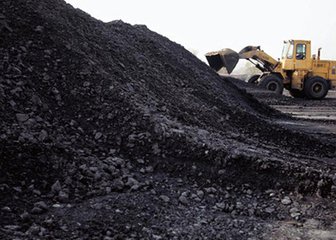1. Geological conditions due to the existence of the fault makes the 14505 trackway floor changes, three different locations of the anchor anchor position shown in Figure 1. From Figure 1 we can see: (1) due to the existence of the fault, No. 5 coal was lifted, 14505 orbital roadway roof into No. 5 coal seam. (2) right anchor cable all hit in the No. 5 coal seam, the coal seam is soft, is not conducive to the hole. (3) Roadway and the left side of the anchor hole, through the three coal and rock interface, and are in the anchor section. In order to further understand the structure and strength of the roof rock, the structure and strength of the roof rock are observed, and the structure of the coal strata within 9m of the middle roof of the roadway near the fault is observed by electronic drilling peephole. The results show that the roof coal The rock formation joints are relatively developed, as shown in Fig. The average uniaxial compressive strength is 10.42MPa; 2.8 ~ 3.6m is carbonaceous mudstone, black, loose block, high carbon content, fissure development, poor rock formation integrity; 3.6 ~ 4.0m for the No. 4 coal seam; 4 ~ 6.5m for the carbonaceous mudstone, black; 6.5 ~ 9.0m for the mudstone, gray and black, rock integrity is poor. In the process of installation of underground anchor cable, it was found that the right side of the roof of the roadway was inclined at about 4 m, and the resin anchor was difficult to push to the bottom of the hole; or the anchor hole was brushed, and the anchoring agent could not be pushed to the bottom of the hole The anchoring force does not meet the design requirements, and the tension does not increase when tensioned to 30 MPa (corresponding to 120 kN). It can be seen from the above analysis, because the roadway rock strength is low, and the joint fissure development, resulting in the anchor hole after forming too large, so that the cable anchor force can not meet the design requirements, thus affecting the anchor high preload , And ultimately affect the support of the entire anchor cable effect.

2 cable body shape cable cable body is generally made with a certain bending flexibility made of steel strand, coal mine with 1 × 7 shares and 1 × 19 shares 2 (Figure 3), and the surface of the rebar rod body Different, cable body surface without smooth ribs. Rong Guan et al. [5] showed that the anchorage strength was greatly improved due to the obvious effect of squeezing, dilatancy and shearing between the screw and the surface of the rebar. It can be seen that the smooth surface of the cable is another reason for the anchoring force of the anchors in the weak coal strata.
3 resin anchor performance Downhole use of two different manufacturers of resin anchoring agent, in order to study the anchoring properties of resin anchoring agent [4], in the laboratory of resin anchoring agent compressive strength and resistance to force test. According to the test standard, the resin anchors of B and B were made into three groups of 40mm × 40mm cubes. The compressive strength test was carried out. The test temperature was about 22 ℃, the time was 24 h, the compressive strength was less than 60MPa, The test results are shown in Fig. It can be seen from Figure 4, A, B two manufacturers of resin anchoring agent compressive strength there is a certain difference. The compressive strength of the three groups of resin anchors is in accordance with the standard requirements, that is, the compressive strength is not less than 60MPa, the compressive strength of the two groups of resin anchors is more than 130MPa and the other is more than 90MPa; The compressive strength of the two groups was larger than 90MPa, and the other group was less than 40MPa, which was lower than the compressive strength requirement of the resin anchoring agent. For the anchors with different thickness of 125mm, the anchoring time is 2h, the pull-out force shall not be less than that of the steel pipe with the diameter of 30mm, 100kN. The test results are shown in Fig. It can be seen from Figure 5, A, B two resin anchoring agent pull resistance there are significant differences. A group of resin anchoring agent 3 groups of pull-resistance test are greater than 130kN, to meet the standard requirements (pull-resistant should be greater than 100kN), and three groups of anchoring agent resistance is relatively stable, pull-out peak no significant fluctuations; The anti-pull force test curves of the three groups were larger than those of the two groups. The pull-out force of the two groups was less than 82kN (81kN in 1 group and 67kN in 1 group). The anti-pull force of the other group was in accordance with the standard For 120kN. It can be seen that the instability of the resin anchoring agent is also one of the reasons that affect the anchoring force of the anchor cable.



